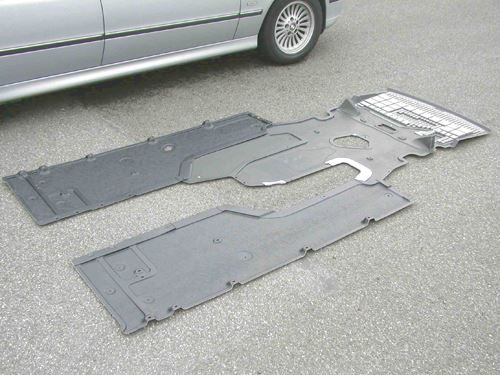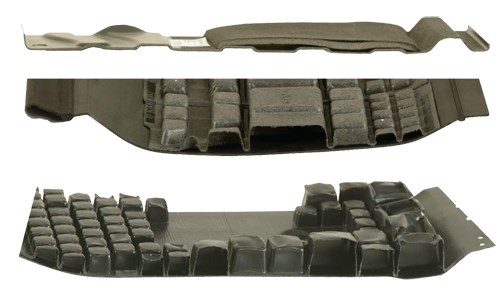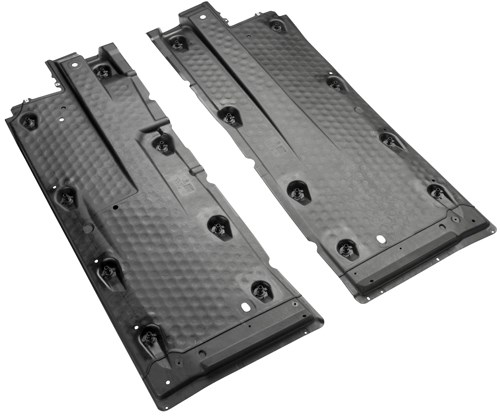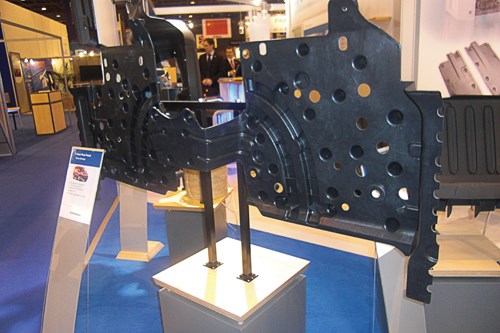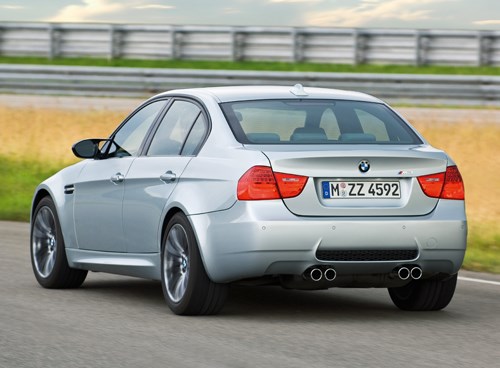UBSs: Coming to North America
Common in Europe and Asia, the composite underbody shield might finally catch on in the U.S. and Canada.
Underbody shields (UBSs) are a great application for composites — great in the sense that they are often sizeable and they make full use of the unique benefits of composites to protect the underbelly of vehicles, improve fuel economy and reduce vehicle noise. Mechanically attached to the body-in-white, UBSs had their beginnings in air-management and engine-noise shields that were positioned between the front bumper and the front axle and other small protective shields placed over vital components, such as gas tanks. UBSs have evolved into a series of large panels that cover nearly the entire undercarriage (except the exhaust tunnel) on passenger vehicles. Today, the full underbody shield is used extensively in Europe and on a significant number of vehicles produced in Asia, but they have been curiously absent from most vehicles designed and built in North America.
North American automobile owners have missed this evolutionary bus for a variety of reasons that speak volumes about the differences between the European, Asian and North American automotive markets. But a number of factors, not the least of which are the recent upheavals in world petroleum markets and the resulting impact on fuel prices and government fuel economy legislation in the U.S., are signaling a shift in the North American market.
Evolution in Europe & Asia
Full underbody shields first appeared in Germany during the late 1980s and early 1990s because that country has some of the toughest requirements for vehicle-noise abatement in the world — in terms of sound inside the cabin interior and outside on the street.
“One of the major drivers for underbody shields is the German drive-by noise standard,” says Conrad Zumhagen, president of The Zumhagen Co. LLC (Ann Arbor, Mich.), who has conducted several global marketing studies on underbody shields for his clients. “Germany in particular and Europe in general have a high penetration of diesel engines, which typically are noisier than gasoline engines,” he explains. “That, plus the region’s higher driving speeds and historically higher fuel prices, makes a good business case for underbody shields and their ability to reduce noise and improve aerodynamics and fuel economy.”
Dr. Frank Henning, deputy director of the Fraunhofer Institute for Chemical Technology (ICT) (Fraunhofer ICT, Pfinztal, Germany) and director of Lightweight Technologies at the Institute for Vehicle System Technology (Karlsruhe Institute of Technology, Karlsruhe, Germany), says, “There are multiple reasons for the application of UBS systems on cars in Europe. Among the most important are the reduction of fuel consumption by an efficient management of aerodynamics, and new legal regulations for reducing vehicle noise. Indeed higher fuel costs in Europe, plus legislative issues have been the major initiators for the development of these systems.” Not only do UBSs help quiet vehicle noise, they also improve fuel economy. “Shields can provide up to a 10 percent improvement in aerodynamic drag coefficient, or Cd,” says Steve Parks, chair of the United States Council for Automotive Research LLC’s (USCAR) Aerodynamics Working Group (Southfield, Mich.) and a senior engineer in the Vehicle Engineering/Aerodynamics Dept. at Ford Motor Co. (Dearborn, Mich.). “For typical North American vehicle applications, this can translate into a 1 to 1.5 percent improvement in EPA-averaged city/highway fuel economy and up to a 3 to 5 percent fuel economy improvement at highway speeds.”
German automakers use full-length UBSs all the time. Depending on how important the German market is to them, other European automakers have followed suit; however, even now, not all European automakers use UBSs on all their vehicles. Similarly, although the German market represents significant sales, Asian and North American carmakers have embraced this application for units manufactured in or shipped to Europe. In fact, quiet vehicle interiors have became an important selling feature on upscale luxury brands like Lexus, produced by Toyota Motor Co. (Toyota City, Japan). Many Asian automakers subsequently adapted UBSs for vehicles they produce and sell in their home regions, but the same hasn’t been true of North American OEMs.
As UBSs evolved and became larger, they changed from simple flat panels into complex shapes, providing a multitude of functions. Initially made of steel or aluminum, underbody shields were converted to composites early in the 1990s. “Composites were the ideal materials for these applications,” notes Henning. “Their inherent versatility allowed efficient aerodynamics, sound damping, heat management, corrosion resistance, high stiffness and impact strength to be designed into lightweight and economical parts.”
“With underbody shields,” Zumhagen adds, “you want toughness, chemical resistance, low-temperature impact and high stiffness per area weight. And you want this in thin sections across a large part that should be as light as possible.”
One of the few North American molders that has produced composite UBSs in the past 10 years, Continental Structural Plastics (CSP, Troy, Mich.) molds and ships the parts to assembly plants operated in North America by transnational European automakers. CSP vice president Thomas Hillborn notes, “The vehicle underbody has a lot of geometry, so these are complicated parts that have a lot of thought going into them. They must manage a lot of wind turbulence, plus stone impact, water, heat and sound — in short, all the properties that composites have offered forever. And, with shorter vehicle runs, composites tooling is a lot more cost-competitive [than steel]. That’s why they were a natural here.”
Materials: Survival of the fittest
Initially, most composite UBSs were produced via compression molding, using polypropylene (PP)-based glass-mat thermoplastic (GMT) with chopped glass mat. The market leader, then and now, is GMT supplier Quadrant Plastic Composites (Lenzburg, Switzerland), whose conventional GMT products were used on larger and larger panels throughout the ’90s. GMT is well suited to the application. It forms a very tough, ductile composite even at low temperatures and can be molded in large, flat configurations with a reasonable amount of design detail (e.g., ribs for selective stiffening). Replacing metal panels with GMT panels not only reduced weight and eliminated corrosion but also lowered tooling costs for low- to medium-production volumes. In sections of the vehicle that required better heat protection, metal shields were added to the GMT to radiate heat; where greater sound deadening was needed, acoustic “patches” were used. In sections where higher mechanical properties were required, GMT with engineered fabrics could be added selectively.
In the late ’90s, the first PP-matrix, pelletized long-glass-fiber thermoplastic (LFT) composites for injection molding came on the market. Some UBS suppliers that had injection molding capability began evaluating these products in the hopes of saving material costs, increasing parts integration and boosting production speeds. But they soon learned that the underside of a vehicle is a tough place to play. LFT-based UBSs are prone to cracking problems, which result from lower impact strength due to LFT’s shorter glass fibers. As a result, most of the programs that changed to injection-molded LFT abandoned it on the next program update.
Some suppliers converted to newly emerging inline compounded (ILC) direct-LFT (D-LFT). The use of extrusion-compression or injection-compression-moldable D-LFT offered longer fiber lengths and higher stiffness than pelletized LFT. D-LFT processing also proved to be more flexible by making it possible to later incorporate engineered fabrics to boost local stiffness — as was done with GMT — but at a lower cost. D-LFT equipment manufacturers include Dieffenbacher North America Inc. (Eppingen, Germany), KraussMaffei Technologies GmbH (Munich, Germany), Husky Injection Molding Systems Ltd. (Bolton, Ontario, Canada) and PlastiComp Inc. (Winona, Minn.).
Other suppliers returned to compression-molded GMT but use a slightly different form called lightweight reinforced thermoplastic (LWRT). Not as tough as GMT, LWRT offers high stiffness per area weight thanks to high glass lofting, which reduces density and offers excellent sound deadening, depending on the degree of consolidation (compression) of the sheet-form product. LWRT is supplied by Quadrant and AZDEL Inc. (Forest, Va.). Although LWRT panels are typically thicker than those in traditional GMT, LFT or D-LFT (e.g., nominal walls of 4.0 to 7.0 mm/0.16 to 0.28 inches for LWRT vs. 1.8 to 2.0 mm/0.07 to 0.08 inches for D-LFT), they are nevertheless lighter in weight.
Early in the current decade, these two new types of thermoplastic composites began to erode traditional GMT’s share of the underbody shield market. Today, the majority of full-length UBSs on vehicles in Europe and Asia are produced in LWRT, D-LFT or a combination of the two.
North America: Different evolutionary path
Vehicles designed and built in North America, on the other hand, tend to sport a pastiche of small panels that cover vital undercarriage components, such as fuel tanks, fuel and brake lines and carbon-canister brackets, plus the lower closeout panel for air management that attaches to the underside of the fascia. True underbody shields are few and far between. North American-built vehicles that do have them are so equipped for reasons that differ from those that motivated European adoption.
“The trends that drove UBS development in Europe — tough noise standards, lots of diesel engines, high driving speeds, and high fuel prices — just don’t exist in North America,” explains Zumhagen. “So shielding here has primarily been for undercarriage protection, and it’s generally been applied to vehicles that might go off-road, like pickups, SUVs, and CUVs.” Because these “skid plates” are primarily used for protecting the engine compartment, they tend to span only the area between the front bumper and the front axle. Further, they use different materials — either metal (steel or aluminum) or thermoformed or injection-molded, unreinforced high-density polyethylene (HDPE) or PP. This is not to say that there are no vehicles with full UBSs in North America. Automakers that use full-length shields in other geographies tend not to remove them when they import vehicles to North America and/or begin producing the same vehicles on those shores.
Despite their proven benefits, North America automakers — even those that use them on vehicles sold in Europe and Asia — haven’t embraced full-length underbody shields in composites. Why? Part of the answer is that North America (particularly the U.S.) has long enjoyed very low fuel prices, and legal highway speed limits generally have been far lower than those found in Germany. Until recently, therefore, fuel efficiency has been less important in the U.S. than elsewhere in the world. Some sources note that North American automakers have tended to focus on manipulating aerodynamics of the vehicle front end and air dam rather than the undercarriage. Additionally, there is less emphasis on noise abatement. Concern about highway noise is addressed by erecting barrier walls between residences and roads rather than requiring European-level efforts to quiet vehicles. Furthermore, there has been high sensitivity to adding cost, so design changes that were perceived as unnecessary weren’t funded.
Adaptive pressure
All this seems to be changing at last. Reportedly, three North American programs launched in 2010 will feature full-length UBSs, and many more programs are coming along behind these. Why the sudden interest? Joseph George, product manager at Quadrant Plastic Composites’ Northville, Mich., location considers the large fuel-price spike in 2008 to be a significant catalyst. “Record fuel prices and changes in CAFE [Corporate Average Fuel Economy] requirements certainly created pressure to find ways to improve fuel economy — and to do so quickly,” says George, who helped validate the company’s LWRT composites on upcoming programs. “All the new programs that are coming out now are using shields for aero[dynamic] reasons as well as protection.” As they reviewed their options, automakers observed that they were already using a number of tools to produce a series of small shields that, in the end, covered only a small area of the undercarriage. “They realized they could use a single tool to make a really large part that would cover the entire underside and would bring additional benefits besides,” he maintains. “The math simply made more sense this time around.”
Do these new programs, then, represent a trend? Zumhagen says it’s too soon to tell. He believes there is a growth opportunity for UBSs in North America but thinks it will be slow to catch on. He’s not sure there’s enough evidence yet, with regard to the new programs that are launching, to say they constitute a trend. But George says the trend is real, and he is supporting numerous programs that will be launching over the next few years. UBSs in LWRT are, in fact, often molded as a single large panel anyway, and then cut into pieces for attachment around the vehicle underside. Because LWRT is molded via thermostamping instead of high-speed compression molding as conventional GMT and D-LFT are, presses with much lower tonnage can be used to mold a single large shield or several shields in a family tool as long as the platen size is sufficient. Then the large part is cut into smaller panels with a waterjet, and the smaller panels are pieced around the underside of the vehicle.
George says that one of the biggest challenges he faced with these new programs was finding infrastructure to mold the parts in North America. Although several tier suppliers have large compression-molding presses with sufficient platen size to produce UBSs, the question is whether it’s cost-effective to mold parts that only need a few-hundred-psi forming pressure on high-speed presses designed to deliver thousands of tons per stroke. The breakthrough came when George enlisted the help of headliner manufacturers. Not only do they already have large-platen presses that are better configured for low-pressure forming operations, but they also use waterjet cutters.
However, George cautions that UBSs are not just headliners mounted on the bottom of cars. Rather, special formulations are required for both formability and stone impact, the latter enhanced via special films and scrims that toughen the surface and help protect against stone impingement and water intrusion. These surface treatments aren’t required for traditional GMT, LFT, or D-LFT — a fact D-LFT proponents are quick to point out. Further, the treatments increase cost and assembly steps and complicate recycling efforts for LWRT shields.
Shifts: Tiny and tectonic
Current trends in European UBS systems seem to be focused on taking out weight and cost (as with so many automotive components) and tweaking other features to improve durability and sound-damping properties. For example, CSP’s Hillborn says his company has developed a proprietary sound-deadening technology for LWRT shields that makes use of intrinsic properties of the material as well as processing know-how. He also notes that D-LFT moldings keep getting thinner without using ribs. Ticona Engineering Polymers (Florence, Ky.) reports it has developed a new long-strand pelletized LFT family for compression molding that more than doubles the glass length typically seen in LFT (from 11 to 25 mm or 0.43 to 0.98 inch), approaching D-LFT mechanicals.
A potential contender for UBS applications is a new direct-thermoset process involving sheet molding compound (SMC). Called direct-SMC or D-SMC, it is being codeveloped by a German consortium that includes Dieffenbacher, its subsidiary ASA GmbH (Anlagen- und System-Automation, Walzbachtal, Germany), Fraunhofer ICT, RESPECTA Maschinenbau GmbH (Wülfrath, Germany), Projektträger Jülich (PTJ, Jülich, Germany), M-Base Engineering + Software GmbH (Aachen, Germany), BYK USA (Wesel, Germany), Reichhold LLC2 (Research Triangle Park, N.C.), Polytec Composites Germany GmbH & Co KG Composites Germany GmbH (Kraichtal-Gochsheim, Germany) and Johns Manville (Denver, Colo.). The program, called DuroVision, is sponsored by the German Federal Ministry of Education and Research and has focused on developing a direct manufacturing process for fiber-reinforced thermosets. The process allows for rapid, reproducible manufacturing of compounds and components in a single process step. The technology reportedly yields parts capable of Class A surface quality and avoids storage and shelf-life restrictions common with conventional SMC. “Direct-SMC could be perfectly applied in hot areas and save the costs of the normally used aluminum heat shields,” says Heinrich Ernst, who retired last October as head of Dieffenbacher’s Composites Division but still consults for the company. “D-SMC offers shorter cycle times and lower materials costs vs. standard SMC and presents the possibility to reduce part thicknesses, based on its better flow behavior.” With the company for 23 years, Ernst was instrumental in helping to develop both the D-LFT and D-SMC processes. Initial commercial applications for the latter are said to be under development.
Another Dieffenbacher/Fraunhofer ICT advancement in D-LFT composites has been the ability to tailor the charge by selectively comolding engineered fabrics in locations that require additional mechanical properties. This allows D-LFT to approach high-performance GMT’s properties at lower cost and greater flexibility. This same team also has worked on the use of recycled (melt-reprocessed) material for D-LFT’s inline compounding process and notes that tailored D-LFT with recycled content is already being integrated into UBSs on commercial vehicles in Europe.
What’s next? CSP’s Hillborn thinks the main change will be increased parts consolidation, which may go as far as integrating components like trunk spare-wheel wells. Henning already sees significant trends in the direction of underbody modules, where composites would be used to complete entire underbody segments that are integrated into the body structure. Many supercars already use carbon fiber-reinforced polymers for the entire floor pan and drivetrain tunnel. And USCAR is working on an ambitious research program, using a form of SMC reinforced with engineered glass fabrics to design a full composite floor system capable of passing 2012 North American vehicle requirements.
Related Content
The potential for thermoplastic composite nacelles
Collins Aerospace draws on global team, decades of experience to demonstrate large, curved AFP and welded structures for the next generation of aircraft.
Read MoreThermoplastic composite, tube-shaped preforms for large-volume manufacturing
Starting with the sporting goods and bicycle market, French startup 3DiTex targets its continuous preforming system for thermoformable, thermoplastic composite tubes in complex geometries.
Read MoreBraided thermoplastic composite H2 tanks with co-consolidated molded boss areas to fit EV battery space
BRYSON project demonstrates possible designs, automated manufacturing and low permeability concepts, including EVOH liner and novel PPA matrix.
Read MoreAssembling the Multifunctional Fuselage Demonstrator: The final welds
Building the all-thermoplastic composite fuselage demonstrator comes to an end with continuous ultrasonic welding of the RH longitudinal fuselage joint and resistance welding for coupling of the fuselage frames across the upper and lower halves.
Read MoreRead Next
Cutting 100 pounds, certification time for the X-59 nose cone
Swift Engineering used HyperX software to remove 100 pounds from 38-foot graphite/epoxy cored nose cone for X-59 supersonic aircraft.
Read MoreNext-gen fan blades: Hybrid twin RTM, printed sensors, laser shock disassembly
MORPHO project demonstrates blade with 20% faster RTM cure cycle, uses AI-based monitoring for improved maintenance/life cycle management and proves laser shock disassembly for recycling.
Read MoreUltrasonic welding for in-space manufacturing of CFRTP
Agile Ultrasonics and NASA trial robotic-compatible carbon fiber-reinforced thermoplastic ultrasonic welding technology for space structures.
Read More
.jpg;width=70;height=70;mode=crop)
